by Mike Gulett –
At one time I thought that the Kaiser Darrin was the first fiberglass production sports car.
My first thought is that I could not have been wrong but then I realized that I have been wrong plenty of times before. So, I did some more research and it is not entirely clear to me if the Kaiser Darrin beat the Glasspar G2 car to market. It may come down to the definition of a “production sports car”. Some people, namely General Motors, think it was the Chevy Corvette. Although the Corvette is certainly the most successful fiberglass bodied sports car it seems like it was not the first one in production.
The Glasspar G2 was a sports car body first produced by Bill Tritt in 1949. Bill Tritt was a fiberglass boat manufacturer in Southern California when he built his first car body for a friend’s hot rod. This first car was called the Brooks Boxer and was completed in mid 1951. Some design changes were later made and the result was the Glasspar G2 also sometimes called the Yankee Clipper.
The Glasspar G2 is certainly made of fiberglass but initially it was sold as a body only and I have found conflicting information about when a real car was introduced and if it was sufficient enough to classify it as the first production fiberglass sports car rather than a kit car.
Supercar.net has this to say,
The Yankee Clipper has been called the world’s first fiberglass-bodied car. The engine was positioned far back in the chassis to achieve good front-to-rear weight balance. Because of the car’s neutral handling, many were used as race cars.
These roadsters also became a favorite in the Hollywood circles and attracted owners such as Humphrey Bogart, Gary Cooper and Rosemary Clooney. This was due to the car being featured in many auto publications of the period, including Road and Track, Motorsport and Motor Trend.
Notice the quote above says “The Yankee Clipper has been called the world’s first fiberglass-bodied car.” – not that it is the world’s first fiberglass-bodied car.
Some sources claim the Glasspar G2 was the first fiberglass sports car and others like the Undiscovered Classics (aka Forgotten Fiberglass) web site are not entirely clear on the question. Undiscovered Classics is a great resource for anyone interested in the fiberglass car culture.
Maybe whoever is writing the history tells it like they want to or maybe the low production numbers of the Glasspar G2 (around 10 complete cars made by Glasspar not counting the customer built cars) do not compare to a much bigger company like Kaiser which made 435 Darrins.
Either way I like the Glasspar G2, or Yankee Clipper, it is a beautiful design that apparently was also a fast car.
The photos above are from Supercars.net and the old ad and movie star photo below are from Forgotten Fiberglass.
Let us know what you think in the Comments.
A version of this article was first published in January 2016.
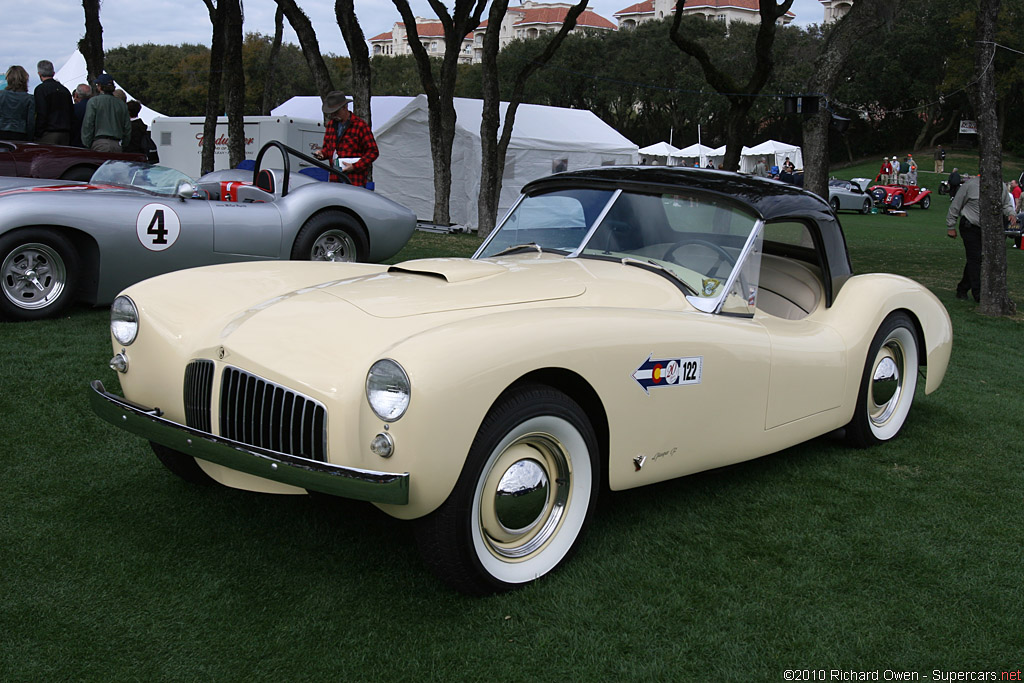
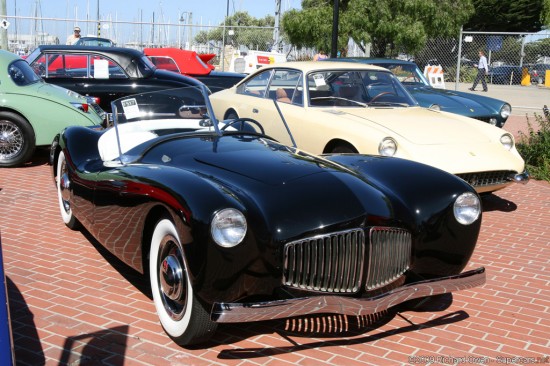
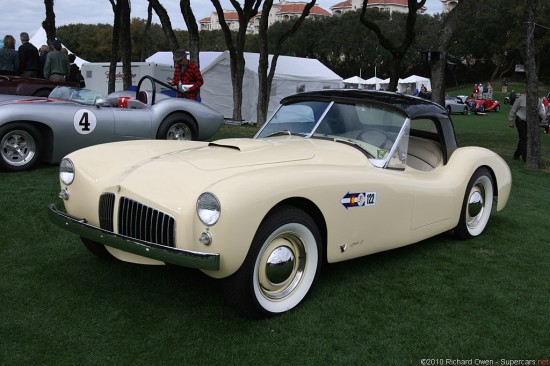
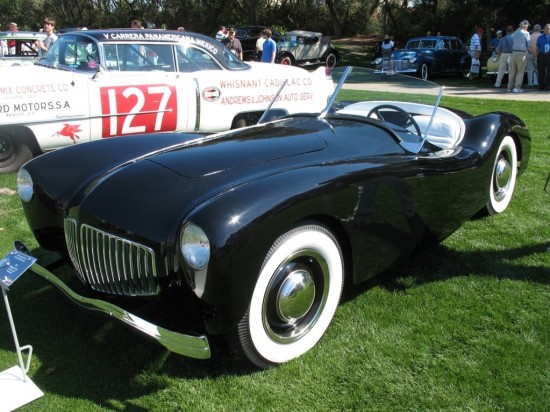
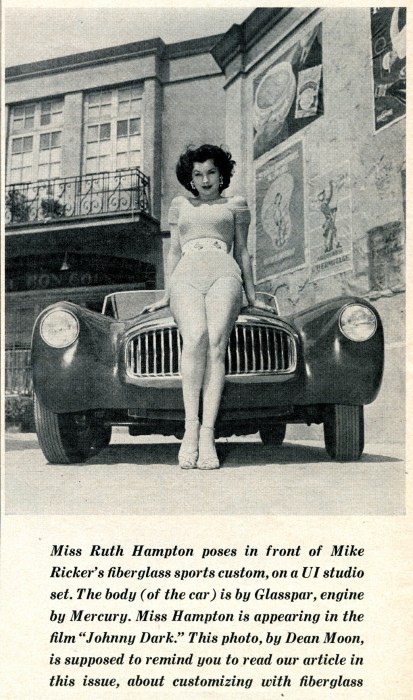
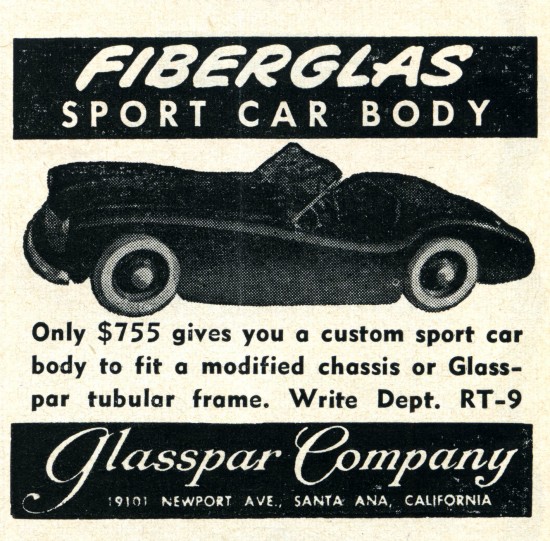


~ i consider Geoff Hacker’s Forgotten Fiberglass data base the evolving source for information on the early post war sport custom auto segment. i haven’t read every article but i am working on it.
the Nash grill on the Mike Ricker G2 is about my favorite looking Glasspar.
Bill Tritt also made the Autopia cars at Disneyland 🙂
Yes. He also designed and made the first series Woodill Wildfire, the Glasspar Ascot and the Volvo Sport. He did not design the Autopia bodies (thank God!), but built them, using the same chassis supplier (Mameco) that he did for the Glasspar competition G2.
my Mamaco Woodill Wildfire was titled as a Mamac in California in 1953 they must not have had room for the last letter on the pink slip, as they called them back then. I sold the Mamac in the 80s in Upper Michigan, often wonder where it is now? It had a big block chev. when I sold it
What about the Kurtis Kraft of late 40’s, made out of fiber glass? Those are to be considered…
Does anyone else have an opinion? I read this post on Forgotten Fiberglass and I cannot tell if the first Kurtis Sports Cars were all fiberglass bodies or part fiberglass. Here is a quote – “And the KSC was the first car in the world to use fiberglass components in its construction.” Fiberglass components not a fiberglass body. It is still confusing.
http://www.forgottenfiberglass.com/?p=18244
~ ain’t google great??
its chassis was integral with a body comprising 10 panels, all aluminum except for hood and rear deck, which were fiberglass.
Thank you, that helps explain why there is so much controversy – some body parts of the Kurtis Sports Cars, rather than the entire body, were fiberglass.
The controversy may not be over yet, however.
~ yes indeed. the particular advantage of Geoff’s research is his readiness to accept that undiscovered facts may yet come to light.
. have you seen Geoff discussing his ’47 Kurtis-Omohundro Comet w/ Leno at Pebble Beach? http://www.jaylenosgarage.com/collections/sports-cars/1947-kurtis-omohundro-comet/index.shtml
Wish I could find a Glasspar for sale
@dperry – check with Geoff Hacker at Forgotten Fiberglass.
Hello dperry ..this is my email if you are interested email me patrick.molina21@gmail.com ….
For those of you that don’t know it, the KD isn’t even the first production fiberglass sports car. Even Corvette fans give that award to the Woodill Wildfire which originally used a Glasspar manufactured body. So I guess the puts the KD as the first production fiberglass sports car put out by a major manufacturer! Oh, yes, and by the way for your further information, Bill Tritt built the prototype KD for Dutch and according to Bill when I spoke to him in 1996, he never got paid for it!! Fred Roth Americansportscars.com
Thanks for the info Fred. I need to research the Woodill Wildfire.
I feel compelled to add a little to this discussion, being one of the few subjects I’m pretty familiar with!
Dutch Darrin never DID pay dad for his help, which was a hell of a lot, considering that Darrin knew Zip about fiberglass construction. The KD was a pretty unusual car. The first series Wildfire was a modified G2 that shared most sub components with the standard Glasspar. The second series was something else, and I personally don’t find it all that great looking – but that’s just me.
Thanks for setting the record straight, Fred.
Matt Tritt
Hello Matt, untill I did read your comment I wasn’t aware of your existence, sorry for that.
As owner of a 1957 Volvo P 1900 (#63) and a 1954 prototype (only running chassis) I am very interested in all possible information on the P 1900. Please check out my site: volvomuseum dot nl in Holland where you can find some information and pictures.
Might it be possible that you have some (family)info about productieon, contacts with Assar Gabrielsson or even pics?
Please let me know, Best regards, Ernst Haselhoff Lich Kasteleijn of Loosdrecht, Holland (info@haselhoffbv.nl)
I agree on the type one Wildfire being better looking but hey I’m a little one sided on that matter!! Your dad didn’t like the changes Woody made on the base G2 but I felt the MG-ish dash and squared off rear really added a little extra “Bling” to an already beautiful car.
To my knowledge the USA magazine Life 1952 spent an article on Bill Tritts Glasspar, beiing the first polyester bodied sportscar. The exact date I must look for.
As owner of a 1957 Volvo P 1900 (#63) and a 1954 prototype (only running chassis) I do have a lot in my archives. Please check out my site: volvomuseum dot nl in Holland where you can find some information and pictures.
Best regards, Ernst Haselhoff Lich Kasteleijn of Loosdrecht, Holland
Maybe Matt Tritt knows when the first Glasspar was produced…
Hi Guys…
1939: Ford makes fiberglass trunk for car and hits it with an ax (publicity photo)
1941: Ford makes hemp based fiberglass car – full body
1941-1945: Kaiser tests fiberglass bodied concepts during WWII
1946: Owens Corning created Project Y – car still exists
1946: Dutch Darrin makes first plastic car (5 passenger)
1947: Dutch Darrin Crosley fiberglass concept produced (car still exists) (1947 year is still being investigated)
1949-1950: Kurtis Sports Cars built with optional fiberglass fenders (front and rear) and hood and trunk – 6 total possible fiberglass panels. Fiberglass built by Paul Omohundro’s company – partner / collaborator with Frank Kurtis
1951: Four fiberglass cars debut at the 1951 November Petersen Motorama at Los Angeles California: Eric Irwin’s Lancer, Bill Tritt’s Glasspar G2 (the Brooks Boxer at the time), John Wills Skorpion and Wasp. A flying car built with a fiberglass body also debuted (Aeorcar or Convair – have to check)
1951 – May – Irwin Lancer built and running (Modern Man, Josephy Wherry author, November, 1952)
1951 – June – Glasspar G2 built and running (Modern Man, Josephy Wherry author, November, 1952)
* Wasp/Skorpion cars built and running (but I cannot verify in-period mention of this yet).
1952: 20+ fiberglass marques burst forth in 1952.
1952 – February – Life Magazine article showing Glasspar bodies catapults their firm to fame across the world for fiberglass bodied sports cars.
1952 – August: Darrin announces his concept project as the “Darrin Competition Sports Car” By November 1952 this car (the concept we now call the Kaiser-Darrin) is being touted as a possible Kaiser sports car (November 17, 1952 Newsweek)
1952 – November – B.R. “Woody” Woodill debuts the “Wildfire (modified Glasspar body) as a “Willys Sports Car.” By Feb/March of 1953, this is retraced as “incorrect” by Willys who states this in Time Magazine (March 2nd, 1953).
1952: Fiberglass cars shown on covers of magazines including Glasspar and Skorpion
1953 – January – official announcement of Kaiser Darrin leaked to press – front cover and inside of January 1953 “PIC” Magazine (one of the outlets).
1953 – February – Official announcement of Kaiser Darrin sports car released in PR statement by Kaiser. Total cars that exists at time – 1 to 3 cars (still in research, so far 3 cars total show up in the Fall of ’53)
1953 – January 17 – The Corvette Dream car shown for first time at the Motorama at the Waldorf Astoria in New York City – 1 car exists.
1953 – January 18 – Motorama announcement by Chevrolet that 200-300 plastic bodied specials will be built as test.
1953 – spring/summer/fall – strike with autoworkers delays Kaiser Darrin production. However, fiberglass bodies built for them during this time by 3-4 companies (stockpiled).
1953 – Fall: Corvettes debut at Chevrolet dealerships across America – most are spoken for (sold) before they arrive.
1953 – July – The new Woodill Wildfire debuts on the cover of Motor World (June 17, 1953) –
1954 – Spring – Kaiser Darrin Sports cars begin to arrive in dealerships across America.
SUMMARY: So….4 fiberglass sports cars debuted at the 1951 November Petersen Motorama at the same time. Lancer was the most famous from November 1951 to February 1952 (mentioned most times in press.) Glasspar took the lead from February 1952 after the Life Magazine article and really began production in numbers by the Fall of 1952. All fiberglass cars from small firms were hand built – no two the same. From the research we’ve done and collaborated with other historians, productions lines and consistency (similar to homologation) needs to be present for a “production” status to be awarded.
The winners….as they stand in research as of today:
* First fiberglass PRODUCTION announcement of a sports car in America: Kaiser Darrin – this included a running/driving model in the fall of 52 (several printed period articles available – Exhaust Notes, November, 1953 is another)
* First fiberglass bodied PRODUCTION sports car you could buy: 1953 Corvette
* All other handcrafted cars do not meet the standard of “PRODUCTION” – and they shouldn’t. They are handcrafted one by one. Some nicely; some not. Some in tiny numbers by the marques that made them; some not.
And as always, research continues emphasizing period printed articles and press releases so this can change and become even more accurate over time.
Hope this helps gang….
Geoff Hacker
Forgotten Fiberglass
Thank you for this history lesson Geoff.
Gang….
Nice story about a restored Glasspar G2 and an original Glasspar owner on Hemmings today – the car will debut at the 2016 Boca Raton Concours d’Elegance in Boca Raton, Florida in February, 2016):
http://blog.hemmings.com/index.php/2016/01/20/sixty-years-later-a-former-glasspar-owner-finds-another-one-to-restore/
http://www.bocaratonconcours.com/
Come on out to the concours and check out this cool Glasspar G2 next month 🙂
Geoff Hacker
Forgotten Fiberglass
You’ve got it down, Geoff! Something about the Corvette that some might find interesting – that being that after discussions with dad and thoroughly checking out the G2, they rejected the basic precept of fiberglass body construction that provided advantages over steel in the first place. Bodies constructed with the same methods used in boat building – using hand lamination and careful design to enhance strength while lowering shell weight are only possible with skilled labor and expensive materials. Chevy, being a builder of mass-produced autos at the lower end of the market, needed to keep the construction costs down and mold cycle times up; something not possible with hand lamination. Because of this, they adopted the use of chopper guns, which produce a finished product that is both heavy (because of the resin-ritch spray) and inherently weak compared to hand laminates and steel. The Corvette also incorporated many Detroitisms that reflected conventional American stylistic nonsense, which further added weight and gee-gaws not found on European machines. At the time, Corvettes were notorious for exploding under collision impact that wouldn’t have caused much damage to both steel or hand laminated glass bodies. This is because structures made of chopped fiberglass have very little inherent structural integrity – precisely the opposite of hand laminates.
@Matt Tritt….Glad you like the timeline – we’re working on a completed version with photos and annotations with all dated material. I think you’ll enjoy it 🙂 Thanks for the kind words….Geoff
Having personally worked on both a Woodill and Darrin, I would whole heartedly agree that the Woodill is the superior Glass construction. The dry chopped glass of the Darrin had the gel pressed out of it causing delimitation and cracking. One other observation was that it appeared to me that the Darrin was in a hurry and possibly cut corners to make it to market. It was certainly more intricate design that pushed the limits. I recall that the frame construction had to be beefed up in later Darrins as the fiberglass body would flex and crack to accommodate the pocket door design and ensure the windshield would not crack. We also owned a Cad powered Darrin in the 70’s that was subject to horsepower that stress cracked the body with the torque. Dad would quote Dirty Harry, ” A man’s got to know his limitations” and sold this car, fortunately it was restored. As you can see from the article the Woodil in action, it was nicely build complements to Shorty Post’s frame work.
My father, Fred, would have enjoyed this blog and the passion surrounding this unique and fascinating era of vehicles. It takes a special breed of collectors and enthusiasts that don’t mind the itchy fuss of working with fiberglass.
http://www.motortrend.com/news/1952-woodill-wildfire-roadster-review/
Yep. You can’t beat a well done hand laminate!
Geoff Hacker has to be considered THE authority on this subject. HIs copious research and summary articles are among the best. Without his efforts much of this history would be lost.
The key feature of fiberglass was the availability and ease of use to nearly anyone. Fiberglass came about concurrent with the post war DIY movement that swept across America impacting electronics, HiFi, Ham Radio, Woodworking, and of course “Build your own Car”. The material empowered people to sculpt and build not only the designs of small company body shell providers but many of their own designs.
The material innovation allowed for single body shells to be attached to nearly any chassis, converting the look and feel of the driving experience. The peak of this would be the dune buggy. Today the fiberglass movement is championed by “kit car” manufacturers, some using the newer version of fiberglass –
Carbon Fiber.
@Raffi Minasian – thank you for the kind words and follow-up…Geoff
Today’s (Wednesday, January 20th, 2016) Hemming’s Daily Blog has an excellent lead article on the restoration of 1954 Glaspar G2 with a Rocket ’88 V8 engine. Pretty good looking car. The 1954 builders never cut out the doors, and it was the dream of the current owner to restore one like the one he had many, many years ago. Great article! Glenn in the Bronx, NY.
The G-2 was offered with 2 doors, one door (to meet SCCA competition rules), an NO doors. It would be very unlikely that a do-it-yourselfer would have the competence to add one after the fact. No door models are the strongest structurally and have the least rattles.
hear hear
I have a glasspar getting ready to restore need to find out information on a windshield and possibly a few other parts had this car for about 45 years and finally decided to restore it . any information on it would help thanks
I have this 1952 G2 for sale with a buick 322 nailhead and a hydromatic transmission. Comes with the factory hard top and 2 opening doors. Runs and drives very nice. 414-916-4700. $49,000.00 Offers accepted.
Watching Overhaulin’ – The Knock Out Corvette. S10E1
They just claimed that the Corvette was the first fiberglass bodied car, so naturally I had to check and see for myself. Looks like they didn’t do their homework, heck, I found this in about 15-20 seconds. The G2 is a great looking car